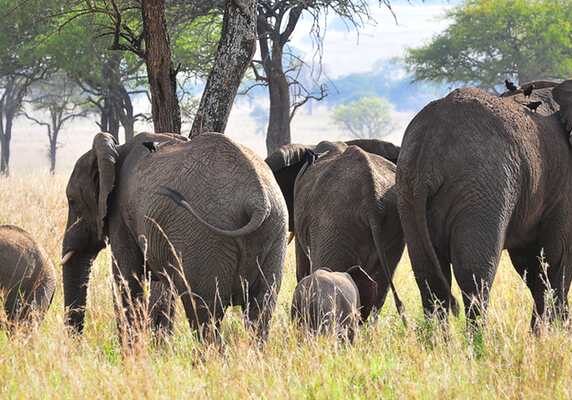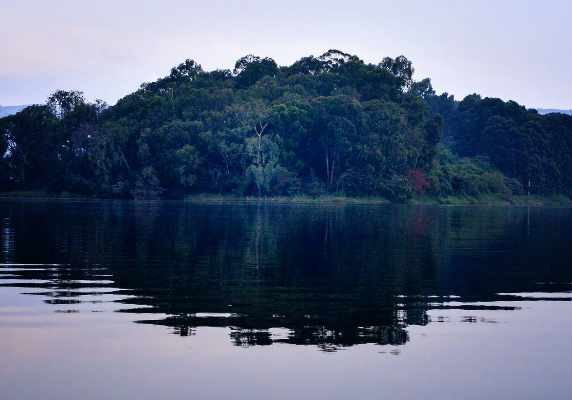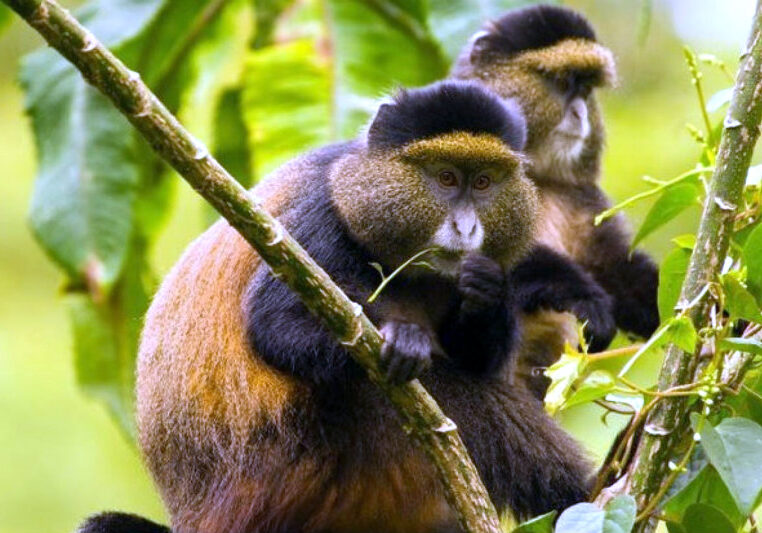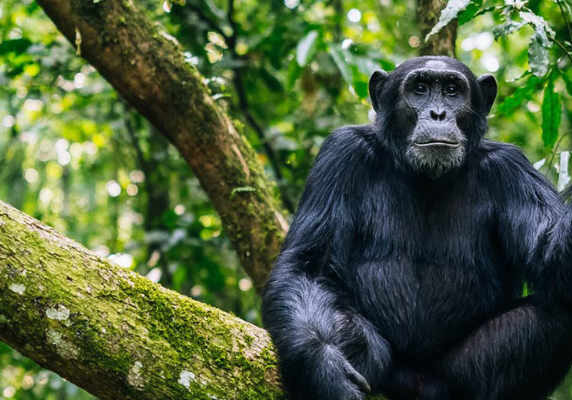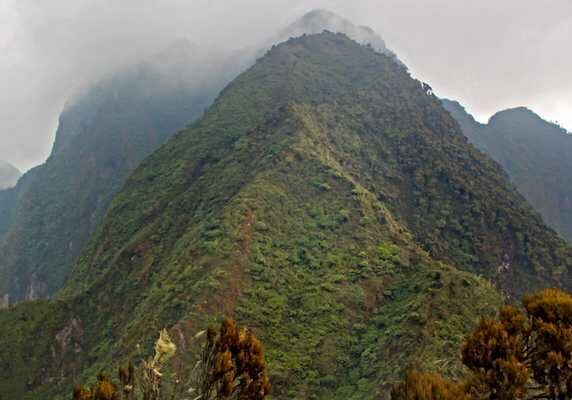
Uganda Gorilla Trek and Safari in Queen Elizabeth NP - 4 Days
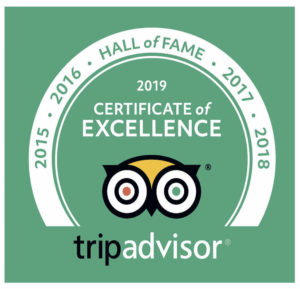 Uganda 4 day gorilla trekking tour with wildlife safari in Queen Elizabeth National Park for you who has very limited time but still want to trek th mountain gorillas as well as a BIG 5 safari in Uganda's best national park. After the gorilla trek, we drive to Queen Elizabeth National Park for a BIG-5 Safari, looking for tree-climbing lions, elephants, hippos, leopard, buffalo among others, as well as a boat safari in Kazinga Channel, crossing the Equator and every places of nice scenery along the drive. There are also lots of other primates, plus over 600 bird species in Queen Elizabeth National park.
Uganda 4 day gorilla trekking tour with wildlife safari in Queen Elizabeth National Park for you who has very limited time but still want to trek th mountain gorillas as well as a BIG 5 safari in Uganda's best national park. After the gorilla trek, we drive to Queen Elizabeth National Park for a BIG-5 Safari, looking for tree-climbing lions, elephants, hippos, leopard, buffalo among others, as well as a boat safari in Kazinga Channel, crossing the Equator and every places of nice scenery along the drive. There are also lots of other primates, plus over 600 bird species in Queen Elizabeth National park.
This 4-days gorilla trek tour and wildlife safari in Queen Elizabeth National Park is a private transfer based safari and we can depart on any day. Tour can start and end from Entebbe/Kigali with any number of participants.
Uganda Gorilla Trek and Safari in Queen Elizabeth NP - 4 Days - Tracking Bwindi Mountain Gorillas with an accompanying African safari searching for Lions, Hippos, Elephant, Buffalo, Hyena, Leopard, etc.
Brief Tour Itinerary
- Day 1: Meet and gree in Kampala or Entebbe at 07:00 am, drive to Uganda's mountain gorillas' sanctuary - Bwindi impenetrable Forest, stopping over at Equator and lunch in Mbarara, sightseeing along the way.
- Day 2: Encounter the gentle giants - Gorilla Trekking in Bwindi Impenetrable National Park
- Day 3: Drive to Queen Elizabeth National Park doing wildlife safaris along the way in the Ishasha Sector & Tree-climbing Lions, Boat trip for game viewing along Kazinga Channel
- Day 4: Early Morning Game drives in Queen Elizabeth National Park, depart back to Entebbe Airport or Kampala for end of the tour.
Day 1: Start your Uganda Gorilla trek tour by driving to Bwindi's impenetrable N. Park (the mountain gorillas' home)
Meet and greet with our local guide in Kampala/Entebbe/Kigali at 07:00 hours before starting the gorilla trek tour on your drive heading to southwestern Uganda to the home of the mountain gorillas, Bwindi Impenetrable National Park.
Our major purpose is that even though you are having only 4 days for this Uganda tour, you should get the maximum out of it. So the tour guide will be pointing out several places of tourist interest as we drive to the gorillas' home. Under normal driving, this should only be about 6 hours but because of these sightseeing instances, it shall definitely be longer. We shall even be traversing Lake Mburo National Park along the way.
There are also several traditional cultural drum-making communities along the way and you could just get interested in the entire process. The lush green organic farmlands of bananas, coffee, tea, pineapple, and fruit markets just look so beautiful along this journey.
We shall also be having a brief stop at the Equator crossing point, just prepare your cameras, please. This line divides the earth into two halves and you have an opportunity to stand on both halves as they take your photograph. There are a couple of interesting experiments to show the earth's movements and their effects and you can ask your guide about these options.
We should be arriving in Bwindi at about 4 pm. You shall be assisted to check-in at your accommodation, which is located very close to the Bwindi Park headquarters. Enjoy your evening in the remote jungles of Africa as you await more unforgettable experiences on the next day.
Uganda Gorilla Trek Accommodation options (all on a full board basis)
Up-market: Mahogany Springs Lodge | Buhoma Lodge | Four Gorillas Lodge
Moderate: Ichumbi Gorilla Lodge| Lake Mulehe Gorilla Lodge | Mutanda Lake Resort
Low Budget: Gorilla Haven Lodge Rushaga | Gorilla Conservation Camp
Day 2: Gorilla Trekking in Bwindi Impenetrable National Park
Waking up amidst African jungle sounds is one unforgettable experience for many visits on the gorilla trek expedition. Yes, with sleeping in the neighborhood of at least 310 species of butterfly, 51 reptiles, 88 moths, and an exceptional 120 types of mammal including 10 primates makes the most memorable African song for any morning. Usually, it is almost a guarantee that the sun will come up at 7 am. Having your breakfast basking in the glory of the morning sunrays, your guide chatting out on the expectations for the day's exceptional experience is the perfect set-up for encountering the mountain gorillas.
After your breakfast, the tour guide/ driver shall be transferring you to the Bwindi Park office from where all gorilla tracking activity commences. You will have a pre-trek briefing with detailed information about the ecology of the mountain gorillas and their conservation, rules, and regulations about gorilla tracking, and other species in Bwindi. After, you will be allocated to a group (not exceeding 8 persons in total). Mountain gorillas live in groups/ or gorilla families. Bwindi now has at least 19 gorilla groups and every day, each gorilla family can be visited by not more than 8 persons, each encounter not exceeding 1 hour. The gorillas keep roaming the jungles of Bwindi but we easily locate them by first trekking to their previous day's location and then tracking signs of their movement to the current location.
Your gorilla tracking experience could be as short as 1 hour or as long as 7 hours, depending on where the gorillas are. The lead trackers will allow for numerous breaks along the way for you to not only catch your breath but also get time to observe the rest of the species in Bwindi which can include forest elephants, buffalo, chimpanzees, L'Hoest's monkeys, red-tailed and blue monkey, black and white colobus and baboon. Bwindi is a prime destination for birdwatchers. Bwindi's 350 bird species include seven which are IUCN red data listed and 90% of all Albertine rift endemics, species which are difficult or impossible to see in any other part of East Africa.
We trek the gorillas through the rainforest and bamboo-covered slopes, accompanied by a guide and gorilla trackers, in search of a mountain gorilla family. The walking can sometimes be tough and long, but when you catch a glimpse of the magnificent silverback, any discomforts will be quickly forgotten. When the gorillas are sighted, visitors will be guided to within 6 meters of the gorillas, and sit around them for a whole hour while gazing into their big round eyes.
Uganda Gorilla Trek Accommodation options available (all on a full board basis)
Up-market: Mahogany Springs Lodge | Buhoma Lodge | Four Gorillas Lodge
Moderate: Ichumbi Gorilla Lodge| Lake Mulehe Gorilla Lodge | Mutanda Lake Resort
Low Budget: Gorilla Haven Lodge Rushaga | Gorilla Conservation Camp
Day 3: Queen Elizabeth National Park – Ishasha Sector & Tree-climbing Lions
After your gorilla tracking experience in Bwindi, it is time for another exciting two days of African wildlife safaris. From the set-off from your Bwindi accommodation, we shall be driving through some beautiful and stunning savannah grasslands on our way to Uganda's most popular wildlife protected area, Queen Elizabeth National Park.
Our first call shall be the park's southern sector, Ishasha. Ishasha is a much more remote and less-traveled part of Queen Elizabeth National Park, but one which has a sense of exclusivity and remoteness. The game densities here are high, and this region has reported some of the largest herds of Elephants anywhere in Uganda, as it is their main migration corridor between Uganda and the DRC. To most visitors, the major highlight is the tree-climbing lions and your guide will outdoors himself to get you closer to them depending on how much time you have to reach the final destination. Lions are not known to climb trees but the ones in Ishasha sector have this habit, more so when the day gets warmer.
We continue driving to the north of Queen Elizabeth National Park where we immediately join in on a 2-hours launch trip along the Kazinga Channel. The 40km Kazina Channel divides Queen Elizabeth National Park into two. Its 80km shoreline attracts large numbers of birds, reptiles, and mammals. A launch trip on Kazinga to view this wildlife spectacle is the park's most famous and enduring activity. You have one opportunity to view wildlife up close: hippos huff and spray at a mere foot away from the boat, and buffalo linger in the shallows. The shores of the channel are also home to an array of birds including pink-backed pelicans, pied and malachite kingfishers, saddle-billed storks, and many others.
Up-market/Luxury: Mweya Safari Lodge | Katara Lodge
Mid-range or moderate facility: Buffalo Safari Lodge | Bush Lodge (rooms) | Enganzi Lodge
Budget price: Bush Lodge (tents) | Simba Safari Camp | Pumba Cottages
Day 4: Game Drives Safaris in Queen Elizabeth National Park, Drive to Entebbe for Departure
We set out early in the morning for a game drive in the northern part of the park in the Kasenyi Plains. A network of game tracks signed by stone cairns explores the plain north of the Kazinga channel. Although this patchwork of grassland and scrubby thickets can make game viewing a challenge, large numbers of animals actually live here. We shall be driving slowly while looking carefully to spot the wildlife.
Across the wide plains, you should expect to see more wildlife like lions, elephants, and solitary buffaloes. This is the best time for opportunities of viewing the cats in action owing to the vast population of Uganda kobs. We have an excellent chance to view just about every animal here at a very close range.
Depart from Queen Elizabeth National Park and safari to Kampala.
Return to your lodge for breakfast and afterward head for Kampala (about 5 hours driving) via Mubende. This route travels through breathtaking scenery and delightfully rolling plantations, some of the best in Uganda. Depending on how much time we have on us we can tour around Kampala’s crafts and souvenirs markets before checking in at your hotel or being transferred to the airport.
Included
- Accommodation for the gorilla trek as indicated on the program (on a full board basis)
- 1 gorilla permit per person
- Sightseeing as noted in the trip itinerary
- Park fees
- Entry fees
- Airport transfers
- Ground transportation by private 4WD vehicles
- Additional guides/porters where appropriate.
Excluded
- Flight tickets and departure taxes
- Travel documentation (visas)
- Travel and medical insurance
- Optional excursions
- Excess baggage charges
- Tips and gratuities for your guides and accommodation staff
- Laundry
- Beverages other than mineral water in the vehicle and at meal times with meals
- Items of a personal nature such as telephone calls, postage fees and so on
Other Memorable Uganda Gorilla Trek and safari Experiences you Might Like
Extend this Uganda safari to Rwanda, or Tanzania with the following tours:
Rwanda
Rwanda Gorilla Trekking, Cultural Village & Lake Kivu Tour – 5 Days
Rwanda Great Primate Expedition Safari – 9 Days
Rwanda Gorilla, Chimp, Primate & Cultural Tour – 8 Days
Best of Rwanda Safari- Rwanda Gorillas Chimps, Monkey Tour – 6 Days
Rwanda BIG APES: Gorilla Tracking and Chimps Trek Safari – 5 Days
Rwanda Gorilla Trekking Tour – 3 Days
Tanzania
Tanzania Wildebeest Migration Safari – 9 Days
Tanzania Wildlife Safari & Zanzibar: Serengeti – Ngorongoro Lake Manyara Park – 10 Days
Tanzania Wildlife Safari: Serengeti – Arusha, Tarangire, Ngorongoro Lake Manyara Park – 9 Days
Uganda Gorilla Trek & Zanzibar Tour – Gorillas and Zanzibar – 7 Days
THE MOUNTAIN GORILLA TREKKING EXPERIENCE
Mountain gorillas are wild animals and, as such, sightings cannot be guaranteed. However, for the last 14 years, no one has trekked the gorillas and failed to see them in Uganda. Certainly, you won't be the one with bad luck! On the trek, once you find the gorillas, you will be allowed an hour with the gorillas and you can only go not more than 6 meters from them. As the gorilla tracking can sometimes take a full day, you will need to go with your packed lunch and lots of drinking water when trekking to the gorillas.
Gorilla trekking timings and conditions vary tremendously as the gorillas move continuously through the rain forest. It is good to be prepared and remember the weather can change with very little warning. The terrain is often steep and through areas where there are no marked paths.
TIPS FOR THE BEST GORILLA TREKKING EXPERIENCE IN UGANDA
Secure Gorilla Trekking permits early
Gorilla Trekking is the most popular foreign tourist activity for Uganda. On every single day, only 128 tourists can trek the gorillas in Bwindi. Uganda has the cheapest gorilla permits prices at USD600 (or USD700 beginning July 2020) for safe gorilla tracking as Rwanda's gorilla permits cost USD1500. This means the competition is quite high for the few gorilla permits in Uganda and it becomes hard to secure gorilla trekking permits a few days to your Uganda gorilla tour (although it is often possible with luck more so in the green season months of October, November, April and May). It is best to have your gorilla trek permit fully confirmed at least 4 months in advance.
Assess your fitness levels
There is a likelihood you could walk for 3-6 hours on a gorilla trek. Gorillas are located deep in Bwindi forest with thick undergrowth over several steep volcanic slopes. Gorilla groups keep roaming this forest looking for their favorite food. They are never stationed in the same place over days. Your gorilla trek will follow this same trend and it is quite unpredictable knowing how long or tough your gorilla trekking shall be. The longer trek is not necessarily a problem, just something to be prepared for. A bit of moderate physical fitness is needed for gorilla trekking in Uganda.
Guides & Porters for the gorilla trek
You will be guided through the forest on your gorilla tracking by a Uganda Wildlife Authority guide whom you will meet at the departure point in the morning of your trek. Your guide can help you book a porter (or two!) so that you can track without having to carry the few essential items listed below in a day pack which you should bring with you. The porters are from the local community and very used to the local conditions and can assist in pushing, pulling and supporting you during your trek to the gorillas. They are usually an additional fee, over and above your safari cost, and you should budget on approximately USD15-20 per porter per day as a fee with additional tipping being optional.
As the porters do not have tracking permits they will be stopped a short distance from the point you will be viewing the mountain Gorillas. Please remember to take whatever you may need from your bag to view the gorillas and rather leave valuables at the lodge/camp.
You will be allowed up to one hour for viewing of the gorillas from when they are sighted by your group. This is to ensure that the wild animals are not overexposed to human presence. Whilst in their presence you will also be required to keep minimum distances from them – generally between 5-7 metres and your guides will ensure this is enforced.
What to pack on gorilla trekking
• Plenty of water – 1-2 litres per person
• High energy snacks in addition to your packed lunch provided by the lodge/camp
• Spare film and batteries for videos and cameras
• Gloves (gardening type are good)
• Waterproof bag to protect photographic equipment
• A hat, sunscreen, mosquito repellent and band-aids might be useful
• A lightweight waterproof jacket/poncho
• Walking sticks are made available at the start of the trek for some of the steeper and more slippery tracks and may prove to be very handy.
Gorilla Trekking Age Limits
The age limit for gorilla trekking is 15 years and the authorities are very strict on this! With special written permission however, a 14yr old might pass.
Videos & Photography for Gorilla Trekking in Uganda
In Uganda, it can be difficult to capture good photos under the dark canopy of Bwindi Impenetrable Forest, as the name suggests! If you are very lucky, you may encounter your gorilla family in a clearing.
Here are a few tips for photographing the gorillas in Uganda:
- If you’re taking photos using a standard point-and-shoot camera, then make sure your camera is fully charged.
- Always take extra memory cards.
- Remember that flash photography is not allowed when you are with the gorillas. Make sure you have your camera manual with you so you know how to disable the automatic flash and automatic focus light functions.
- We recommend a good SLR camera. The best lenses are those with a wide aperture such as f2,8 which allow in max light and are best in gloomy conditions. A 24 – 70 mm and a 70 – 200 m is a good combination. If you have space then consider a 300mm and a wide angle but it’s a steep walk so consider hiring a porter. A 50 mm 1.4 lens is also ideal for low light shooting and something to consider as a standard lens.
- Professional filmmakers require permission and need to purchase filming permits in advance from UWA (Uganda) or RDB (Rwanda).
- Keep your camera and/or phone in a waterproof bag (such as a large Ziploc bag). Cue: you’re in the rainforest.
Professional photographers, film makers or media should advise us at the time of booking as special procedures are required as well as costs to be incurred for photographing and filming.
CAMERA SETTINGS FOR GORILLA PHOTOGRAPHY
File format
Shooting in RAW format is the way to go. A jpeg is smaller in size because it discards a lot of information and so information cannot be retrieved if your exposure is slightly out. If you are shooting in jpeg, make sure your camera is set to the largest file size and also set your white balance according to the light conditions.
ISO and shutter speed
It can get dark in the forest – very dark. And gorillas are very dark subjects. If you have a Nikon D3x or D800 you can shoot at ISO 3200 and get away with it very well. My recommendation however is to try to keep in the range of IS0 800 to 2000 for maximum quality of image. High ISO gives a faster shutter speed but can affect quality and cause noise. Keep ISO as low as possible without getting blurred images. A rule of thumb is don’t shoot below 1/200th of a second with a 200mm lens. If you are using an 80 mm lens then you can shoot at slower speeds of say 1/80th and so on. If the gorillas are on the move you should up your shutter speed to 1/1000th of a second or more.
Metering and priority settings
A good default setting is to use centre weighted metering, aperture priority and an aperture of f5.6 or so. If there is a lot of dark gorilla in the viewfinder you will need to underexpose by up to two stops of light – 2 using your AE +/- button or you will overexpose your image. It is also a good idea to consider manual shooting if you are in fairly consistent lighting conditions. Your camera likes shooting subjects where the differences in exposure are not too extreme and its for this reason that cloudy or shady conditions are often best for shooting dark subjects like gorillas.
Focus
Single point focus is usually always best – you don’t want the camera focusing on the tree instead of the gorilla and usually you will want to lock your focus on the eyes. If you have a group of gorillas that you want to keep as much in focus as possible then focus about 1/3 into the picture. You may want to change focus to multi -point if you have lots of moving subjects but suggest single focus points will give you more control. You will probably shoot on single shot, but may want to change your focus settings to continuous focus and rapid fire if they are on the move and playful.
SHOOTING TIPS
When you are with the gorillas there is a 7 meter buffer rule between you and animals. The reason is that their DNA is so close to ours that it is very easy for them to pick up flu and colds. Gorillas don’t know this rule and so don’t be surprised if they do approach closer (and be ready for it with a wide lens available), but if the guides ask you to move away then always do so smartly.
Your time with the gorillas is precious. Don’t shoot away wildly. Plan your shots. Close ups, wide shots, angles and framing. Think about your options. Also don’t forget the wide shots of Make sure that you don’t spend the whole time looking through the lens. Sit and watch and consider the fact that you are watching one of the gentlest and most fascinating creatures on the planet.
As with all wildlife photography it’s about the moment. Try to catch the little moments such as when the gorillas are interacting or when the sun catches their eyes. Also why not video your friends as soon as its over and let them tell you about their experiences of this fantastic experience.
Queen Elizabeth National Park Safaris
The Queen Elizabeth National Park provides an unforgettable and unique experience for your Uganda safari in search of beautiful scenery and the BIG-5 - lions, leopard, bufallo, hippos, elephant and hyenas.
Queen Elizabeth National Park is 1,978 Km2 in area and is situated astride the Equator in the Western Rift Valley of South West Uganda, close to the southern-most tip of the tabled, mist-covered "Mountains of the Moon - Rwenzori Mountains and is contiguous with Virunga National Park in Democratic Republic of Congo.
It is a region of varied habitats including, open grassland with thickets, thick bush, forest, swamps and lake-shore. Queen Elizabeth National Park together with Virunga National Park in (DRC) completely encircles Lake Edward which is connected to Lake George by the Kazinga Channel.
Queen Elizabeth National Park is Uganda’s most popular savannah reserve and has the widest variety of wildlife of any Ugandan park. The variety of habitats includes grassland savannah, forests, wetlands and lakes. This provides the setting for an extensive range of large mammals and primates. Four of the Big five are present (rhino are absent) and chimp tracking is available.
This is the most reliable park in Uganda for lion, which is particularly common on the grassy Kasenyi Plains but is more famous for its tree-climbing antics in the Ishasha sector. Huge herds of buffalo and elephant are found in the savannah areas of the park and an amazing number of hippo inhabit the Kazinga channel on which daily boat trips are conducted.
Queen Elizabeth National Park Scenery
Most of Queen Elizabeth National Park is the beautiful open savannah grassland. A huge part of the park is forested however with two forests which are also open tour tourists for guided walks. Chimps tracking can be done in Kyambura Gorge forest and guided nature walks inthe extensive Maramagambo forest in the southeast. Queen Elizabeth National Park is located against a backdrop of the Rwenzori Mountains. Part of the Park's beautiful scenery also includes the Kazinga Channel which connects the two lakes - Lake Edward and Lake George and not less than 10 crater lakes spread across the park. The most accessible part of the park is open savannah, but large forest areas are open to the public.
Weather & Climate in Queen Elizabeth National Park
Because Queen Elizabeth National Park is located just a few miles from the Equators, the area average temperatures are mostly warm for most of the year. During the months of April, May and November, the park receives a bit more rain and this can make some of its tracks hard to navigate if you don't have a 4x4. The commonly known drier season is from January to February and June to July but it often rains even during these months.
Best Time to Visit Queen Elizabeth National Park
Brief but drenching rainstorms often characterizes the days of the Wet seasons (March to May and August to December), but this is also when the park’s environment is beautifully lush and you can greet migratory birds as they pass through. For chimpanzee trekking, though, visit when the park’s trails are more solid underfoot in the drier months.

